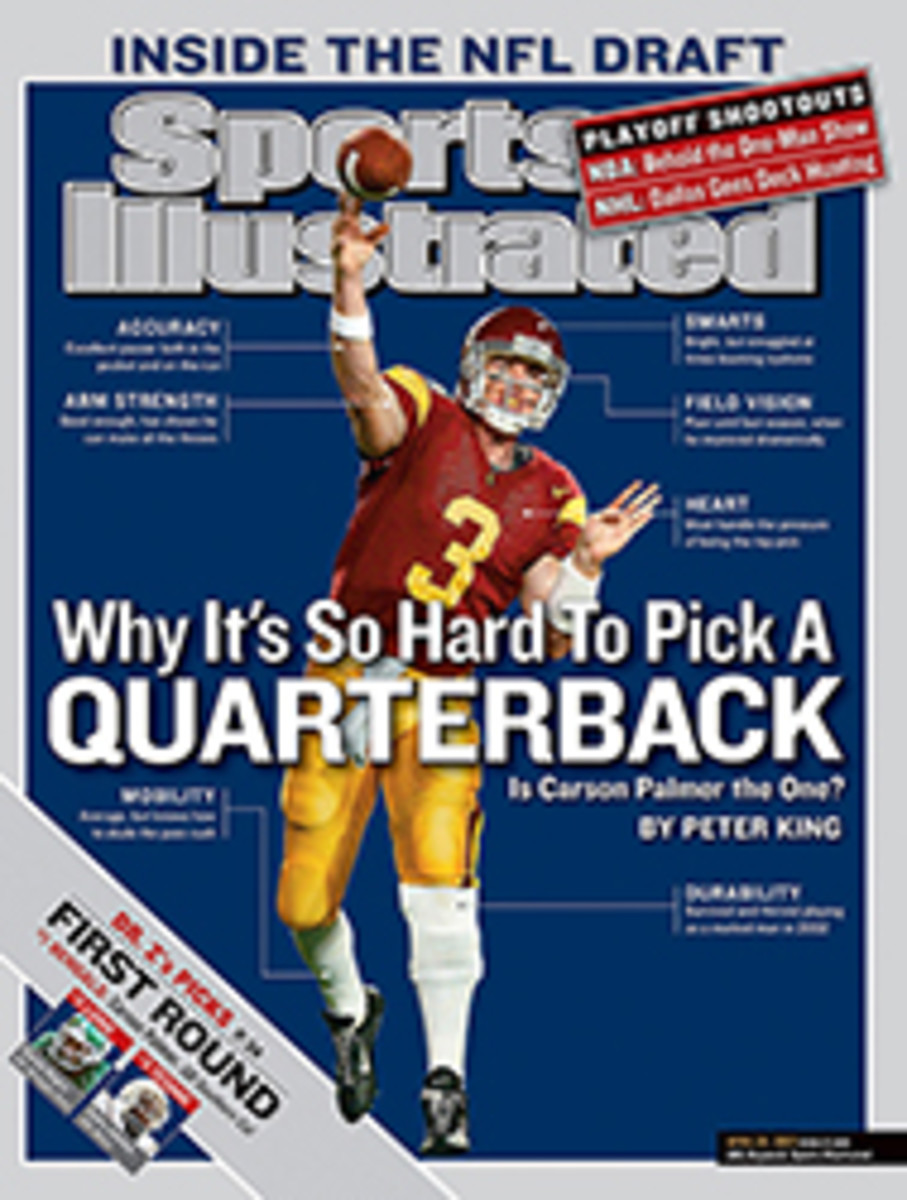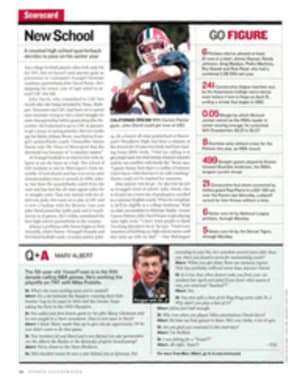
Tiger's Track Going back to his roots, Tiger Woods selected a ramshackle muni for a $25 million makeover
It's a typical day at Dad Miller--balls flying and bouncing
toward flag, fence and parking lot; golfers swarming the
starter; back-nine foursomes laughing and cussing as they
butcher the 614-yard 17th hole, the one Tiger Woods couldn't
reach in two. ¶ "It's a plain old typical public course," one
player says of his favorite 6,025-yard muni. There are bare
spots on tees, power lines sagging over fairways. A sign on an
outdoor bathroom reads, DAD MILLER SEZ: THIS IS THE PAUSE THAT
REFRESHES. There are strip malls and trailer parks so close
that they're almost in play. But after last week, this
$20-a-round track will never be typical again. ¶ On April 16,
three days after the final round of the Masters, the world's
best golfer returned to the scene of his high school matches,
H.G. (Dad) Miller Golf Course in Anaheim, Calif., to launch a
$25 million project that will change the place forever. "It
blows my mind that this little high school punk who used to
play here can give back to the place where it all started,"
said Woods at the groundbreaking ceremony, during which he held
a shovel that he said he "could have used last week" in Augusta.
His $5 million donation paved the way for the first Tiger Woods
Learning Center, an academy in which golf will be only part of
the curriculum. Its centerpiece: a 35,000-square-foot complex
with computer lab, auditorium, cafe and media center beside a
23-acre practice facility and a par-3 course designed by Tom
Fazio. Woods expects corporate partners to donate $20 million.
(Naming rights to the cafe are available for $500,000.) Starting
next year, Anaheim schoolchildren will take English, math and
science classes jointly sponsored by the center and city school
districts, plus "character development" programs created by the
Tiger Woods Foundation and Target stores.
Cynics might ask, "And who knows more about character development
than Target stores?" But it's hard to fault Woods and his
corporate posse for their efforts. By the time they finish giving
Dad Miller the Cinderella treatment, this will be the only
ramshackle muni with a state-of-art par-3 course and three brand
new holes. Still, there are golfers who worry that the project
might cost the course its soul--the funky local color that made
the place unique.
Born in 1877, before golf migrated from Scotland to America,
Henry George Miller went west from Kentucky to Anaheim, a
sun-baked hamlet where he worked for the electric company until
he retired during World War II. By then Miller was a golfer, and
he persuaded friends in local government to build a course amid
the palms, pines and eucalyptus of the town's flatlands. Anaheim
Municipal opened in 1961. Its first pro was Olin Dutra, the 1932
PGA and '34 U.S. Open champion.
In 1970 the 93-year-old Miller aced the short 11th hole to become
the oldest player ever to make a hole in one. Five years later
the course he'd championed was named after him. Another geezer
would erase him from the Guinness record book, but the widowed
Miller was a celebrity, known throughout Southern California as
Dad Miller. He made TV ads for a bank, rode in parades and cut
ribbons at store openings. "When folks opened a business around
here, they'd trot out Miss Anaheim and Dad Miller," says Bob
Johns, the course's head pro from 1976 to '95. "He loved the
attention, and even when he was well into his 90s, Dad liked the
ladies. He'd make sure he got a kiss from Miss Anaheim."
Dad Miller was still playing his eponymous course after his 100th
birthday, hitting five-woods on the 100-yard hole he had aced. He
died in 1979, 102 years old. By then there was a new kid in town.
That year Tiger Woods, age three, shot a 48 for nine holes at the
Navy Golf Club in nearby Cypress, Calif. Before his sophomore
year Woods was the U.S. Junior champ. "We'd all heard about him,"
says Johns, "but nothing prepares you for seeing Tiger play. The
first time I saw him swing--this skinny little kid, just bombing
the ball--my jaw dropped."
On the day Woods made his high school golf debut, Johns chased
news crews off his fairways. "It wasn't fair to the kids he
played against, having TV cameras follow them," Johns says. Woods
shot 29s and 30s in nine-hole matches. After his sophomore year,
his school, Western High, switched its home matches to a country
club, but Tiger never forgot the old muni. During his first
Masters, in 1995, he puzzled reporters by saying that Augusta
National's lack of rough reminded him of Dad Miller.
Now Woods will remake the place with help from Fazio, who is
working with limitations he seldom encounters. The driving range
and the back nine, edged by a mobile-home park and the massive
transformers of an electric-company substation, will get the most
attention. "We'll put the practice range in a drainage area, a
place designed to flood," says Fazio. In fact much of the course
is a floodplain where the county can let water from winter
torrents spread out, keeping Anaheim, Westminster and Huntington
Beach from being deluged. Such torrents come almost every year,
roaring through a concrete culvert that funnels floodwater
downstream from the San Gabriel Mountains. Along with the floods
come trees, trash and the occasional surprise. In 1968 a murder
victim washed up on the back nine. Fazio will sink new drainage
equipment to make the course drain faster.
Others will build a new 15th hole with a pond in front of the
green, and turn the locally famous 17th into two new holes. The
614-yard, par-5 17th is this humble track's signature hole. Even
Woods never eagled the 17th, which bends left through a long
corridor of trees. For Dad Miller regulars, making 5 at 17 has
long been a badge of honor.
"This hole will be destroyed, and it is special," says H.R.
Bartholomew, 70, peering almost half a mile from the back of the
tee to the green. "I guess that's progress." The other day
Bartholomew was on the back nine with the Dad Miller men's club,
and as usual the beer and opinions were flowing.
"They may not screw up the course," one said, "but they won't
make it better."
"Fazio knows what he's doing," said another.
"Yeah, but what about all these new buildings? It's a Taj Mahal
for Earl Woods."
"Well, I won't miss 17. I haven't parred it in years."
Bill (Fly) Fleischhacker, a weathered, mustachioed man lugging a
dusty set of sticks, cackled. "Seventeen's nothin'!" he said.
"I've been over that green in two."
"Have some more beer, Fly," said Bartholomew.
"Thank you, I will." Fly, working on a Budweiser, placed the can
on the fairway a few inches from his ball and smacked a
three-wood into the powder-blue sky.
Last week's groundbreaking ceremony generated headlines,
corporate pledges and more buzz than the old course had seen
since Woods's high school days. Woods strode the poa annua with
his girlfriend, Elin Nordegren, agent Mark Steinberg, Stanford
teammate Jerry Chang and record producer Jimmy Jam, as well as
his parents, Earl and Kultida, who seldom appear together. "We
lived just down Lincoln Avenue," said Kultida. "You didn't even
have to get on the freeway to get here."
During a press conference, her son explained why the project is
important to him. "I play golf for selfish reasons--to win
tournaments," Tiger said. "That's for me. This is for other
people." Rather than building a new course or a golf school, he
said, he wanted to provide California kids with "education and
life development" at what would be the first of many Tiger Woods
Learning Centers nationwide.
Soon Woods joined dignitaries and 200 invited guests for the
dirty work: sharing ceremonial shovel duty with some awestruck
schoolkids. Then he was gone, leaving the details in his father's
hands.
Earl Woods will have what he calls "full operational
responsibility" for the center, which he believes can help
hundreds, if not thousands, of students who will be bused to Dad
Miller from area schools. For decades the city of Anaheim had
leased part of the course from Orange County for $1 a year. When
the lease ran out, the county wanted much more. That's when the
Tiger Woods Foundation stepped in. "We went to the county board
of supervisors," Earl says. "I told them, 'Help us help your
children. We are not here to make money. We want to give back to
the community.' We asked the board to give us land-utilization
approval for the next 50 years, and we got it." A new lease was
worked out between the county and the foundation. The price: $1 a
year.
At the groundbreaking Tiger said he hoped to see the lease
through to its end. "I'll be 77," he said. "If I'm still around,
I'd like to come back and renew it." If that happens in 2053,
Woods could wait another 15 years before returning in 2068 to
hole a dead-arm five-wood at the 11th--and he'd still be younger
than Dad Miller was when he aced that hole.
Last week's hoopla left some grumbles in its wake. A few
old-timers, shut out of the press conference, wondered what Dad
would have thought.
"You mean all this pomp and ceremony?" Johns, the former pro,
asked. "Dad would have loved it. His name's in the papers again."
COLOR PHOTO: DAVID MCNEW/GETTY IMAGES DIGGING IT Woods (with Earl and friends at the groundbreaking) has the monster 17th (top) being remade into two holes.
COLOR PHOTO: PHOTOGRAPHS BY TODD BIGELOW/AURORA [See caption above]
COLOR PHOTO: PHOTOGRAPHS BY TODD BIGELOW/AURORA ROAD HOLE Golfers cross Gilbert Street to get from the 9th green to the 10th tee.
B/W PHOTO: ANAHEIM COMMUNITY SERVICES/HISTORY ROOM (MILLER) FATHER FIGURE A local celebrity who lived to be 102, Miller persuaded Anaheim officials to build the course in 1961.
COLOR PHOTO: VICTOR SPINELLI/WIREIMAGE.COM EARL'S PEARL Woods's father helped negotiate a 50-year lease on Dad Miller with Orange County that costs $1 a year.
"He loved the attention," Johns says of Miller, "and even when he
was well into his 90s, Dad liked the ladies."
"I play golf for selfish reasons--to win tournaments," Tiger
said. "That's for me. This is for other people."

